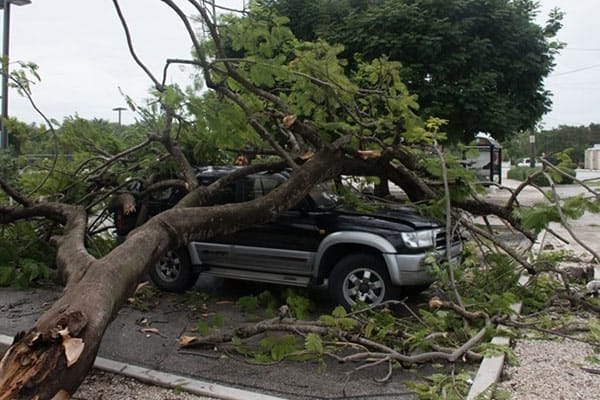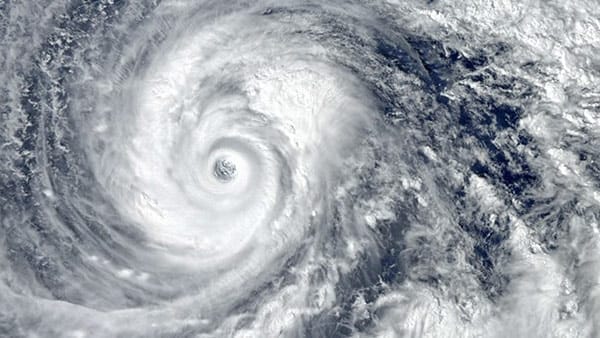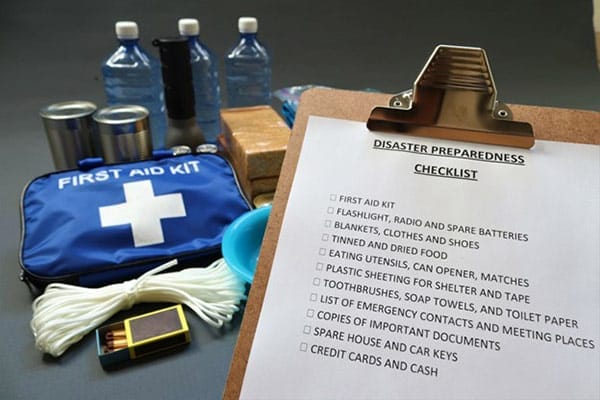[table_of_contents]
What is hurricane season like in Texas? Put simply, there’s a high risk of a hurricane making landfall in the Lone Star State, and they’re not much fun.
Hurricanes are one of nature’s most destructive forces, bringing high winds, flash floods, and heavy rainfall. They bring devastating property damage and often claim the lives of people caught in their paths.
Let’s explore what the hurricane season is like in Texas and how Texans can prepare for when the next one hits.
What Is a Hurricane?
Hurricane comes from the Taino Native American word “hurucane.” Translated, it means “evil spirit of the wind.”
The U.S. National Oceanic and Atmospheric Administration (NOAA) lists storms according to their wind strength. They start as tropical cyclones and build up to major hurricanes. These clouds and thunderstorms rotate over tropical or subtropical waters, such as the Caribbean, and then land on the Texas coast.
The NOAA tropical cyclone classifications are as follows:
- Tropical depressions, which reach maximum sustained high wind speeds of 38 mph or less.
- Tropical storms that sustain high wind speeds from 39 to 73 mph.
- Hurricanes form once a tropical storm reaches sustained high wind speeds of 74 mph or higher. These hurricanes, which come under category 1 and 2 storms, are called typhoons in the western North Pacific and cyclones in the South Pacific and Indian Oceans.
- Major hurricanes occur once winds reach 111 mph or higher and are categorized as a 3, 4, or 5, depending on wind speeds.
Interesting fact: In the northern hemisphere, tropical cyclones rotate counterclockwise. In contrast, those in the southern hemisphere rotate clockwise.
How Do Hurricanes Form?
Sea surface temperatures from 79 degrees Fahrenheit (26 degrees Celsius) or higher in the Atlantic Ocean make meteorologists hurricane twitchy.
Low pressure, called a tropical wave, passes through the area and draws heat from the warm seas. This moisture-rich tropical system feeds the hurricane furnace. Warm ocean air rises into the storm, increasing the low pressure, resulting in more ocean heat firing into the system.
The rising warm air cools, forming clouds and thunderstorms. If the process keeps repeating, then a hurricane may form. But not every tropical wave turns into a hurricane.
Interesting fact: The wind energy from a hurricane equals half the world’s electricity-generating capacity, and 400 times that amount if you add in the clouds, rain, and lightning the storm disperses.
What Are the Categories of Hurricanes?
The Saffir-Simpson Hurricane Wind Scale rates hurricanes from one through to five.
A category one storm (74-95 mph) can bring down trees and power lines, blow shingles from roofs, and cause flash flooding. Category two storms (96-100mph) bring about 20 times more damage, with power outages, power line damages, and extensive roof damage possible to buildings.
A category three storm is a major hurricane (111-129 mph). It leaves homes severely damaged, trees uprooted, and several days or weeks of flooding and clean-up operations. Storm surges are likely, as seen in 2005’s Hurricane Katrina when it reached landfall on the Florida coast.
Category four (130-156 mph) storms will bring catastrophic damage that lasts for months, destroying buildings and taking out utilities like water and electricity. Finally, category five hurricanes (157 mph +) can reduce homes to their foundations, as Hurricane Andrew did in 1992, one of the United States’ worst storms.
Did you know? A slow-moving hurricane can cause more damage and produce more rain than faster moving and more powerful hurricanes?
Enter your ZIP Code and compare electricity rates
How Do Tropical Storms Get Their Names?
Names are given to cyclones once they officially become tropical storms with 39 to 73 mph high winds. Every region worldwide has its own way of naming storms in their areas.
For the Atlantic basin, which comprises the Caribbean Sea, Gulf of Mexico, and North Atlantic, the World Meteorological Organization has six alphabetical lists for Atlantic cyclones. These named storms alternate between male and female names and are rotated every six years. The Greek alphabet (alpha, beta, etc.) is used if the list has been exhausted during one year.
What Is the Difference Between a Hurricane and a Tornado?
There are several similarities between hurricanes and tornadoes: strong, counterclockwise winds (in the northern hemisphere) that roar around a center, albeit some local winds can cause tornadoes to spin clockwise.
In terms of differences, tornadoes are far smaller than hurricanes, rarely travel more than 10-20 miles along the ground, last only a few minutes, and have wind speeds that can reach up to 300 mph. Also, tornadoes tend to form in the U.S. central plains between spring and early summer, caused by warm Gulf of Mexico air meeting cold, dry continental air arriving from the U.S. northwest.
In contrast, hurricanes form nearer the equator, are around 1,000 times larger than tornadoes, and cause havoc to areas up to 1,000 miles wide. Hurricanes also last much longer (several days), often from late summer to early fall, and are always over areas with warm sea surface temperatures. A hurricane making landfall can create tornadoes, whereas a tornado won’t trigger a hurricane.
Does El Niño Affect Hurricanes?
El Niño years occur when equatorial Pacific Ocean waters warm every three to seven years.
There are usually fewer tropical storms and hurricanes in El Niño years because the wind’s vertical shear—the change in wind direction and based on its height in the atmosphere— increases. Greater vertical wind shear helps prevent thunderstorms from forming.
In contrast, in La Niña years, the cooler-than-average Pacific Ocean waters increase the chances of hurricanes in the U.S.
When Is Hurricane Season in Texas?
The Atlantic hurricane season, which affects Texas, officially begins June 1 and ends November 30. The peak months for hurricanes in Texas are August and September.
According to the National Hurricane Center, the average Atlantic hurricane season features:
- 14 named storms
- 7 hurricanes
- 3 major hurricanes from category 3-5.
What Month Do Most Hurricanes Hit Texas?
Hurricanes tend to form early to mid-August, with major hurricanes coming in late August or early September. Mid-August to mid-October accounts for most storm activity. This 90-day window accounts for almost four in five tropical storms, nine out of 10 minor hurricanes, and 96% of major hurricanes.
Bucking these statistics in 2023 was Hurricane Don, the first of last year, classified on July 22 but remaining in the Atlantic Ocean.
Which Part of Texas Gets the Most Hurricanes?
Texas’ Gulf Coast, southeast Texas, and south Texas are those most vulnerable to heavy rains, tropical storms, and hurricanes.
Vulnerable cities include Galveston, Austin, Houston, and anywhere along the coast when hurricane season strikes.
What Contributes to Hurricane Formations in the Gulf of Mexico and Texas?
The famous Texan and Caribbean summer heat warms the Atlantic basin’s oceans, comprising the Caribbean Sea, the Gulf of Mexico, and the North Atlantic.
Low-pressure tropical waves may form when warm sea-surface temperatures begin, usually around 79 degrees Fahrenheit (26 degrees Celsius) or higher. Thunderstorm activity can then trigger hurricane formation.
What Are the Biggest Hurricanes to Have Hit Texas?
The state of Texas has suffered several natural disasters thanks to hurricanes. Some of the most significant major hurricanes to hit Texas include:
- Galveston Hurricane (1900): Category 3 with 8,000 fatalities in a city of 30,000
- Corpus Christi (1919): Category 4 with 284 fatalities
- Hurricane Carla (1961): Category 4 with 125 fatalities
- Hurricane Beulah (1967): Category 5 with 56 fatalities
- Hurricane Rita (2005): Category 3 with $10 billion in damage and 11 fatalities
- Hurricane Ike (2008): Category 3 with $19.3 billion in damage, 24 direct fatalities and 64 indirect deaths
- Hurricane Harvey (2015): Category 4 with 68 fatalities and $125 billion in damages.
What Are the Most Vulnerable Areas in Texas During Hurricane Season?
Anywhere along the state of Texas’s Gulf Coast is at risk during the hurricane season. Cities like Houston, Galveston, Brownsville, and Port Arthur often lie in the path of hurricanes.
How Do Hurricanes in Texas Compare to Florida or Louisiana?
Florida is the U.S. state that suffers more hurricanes than any other, followed by Texas and then Louisiana. Florida’s position as a peninsula means hurricanes can hit it from either side, coming from the Gulf of Mexico or the Atlantic Ocean.
How Can People Prepare for Hurricane Season in Texas?
People living in storm-susceptible areas must be prepared for the hurricane season. Having flood insurance and ensuring your property is covered for storm damage is essential.
The National Oceanic and Atmospheric Administration’s (NOAA) recommendations include:
- Heed evacuation warnings and follow all instructions from local officials.
- Have an evacuation plan. Are there any local safe centers? How will you get there? Plan several routes.
- Assemble essential supplies like non-perishable food, water, pet food, charged batteries, cash, flashlights, and a radio. You will need to listen to weather forecast updates from the National Weather Service to know when it’s safe to wander out. Include everything in this hurricane preparedness kit list.
- Have a secure stash of medical supplies.
- Prepare an inventory of your possessions in case you need to make an insurance claim and submit it to your insurers.
- Consider backup power options like generators for power outages. Don’t use portable generators inside because they release carbon monoxide, one of the biggest killers after storms.
- Think about how you’ll charge cell phones, heat your home, and cook. You’ll also want to consider how people reliant on electricity-powered medical aids will survive.
- Storm-proof your house with secure tiles, storm shutters and doors, and guttering. The garage door is the weakest point of a home. Clear your garden of loose objects that could be blown around once a storm warning sounds. Keep trees well-trimmed to avoid branches being blown off and creating additional hazards.
- Don’t forget to consider your pets: food, litter, water, and safety.
- Write down people’s telephone numbers and those of essential services in case of emergency. The internet may not be available after a tropical storm.
- Don’t use candles.
What Is the Safest Place to Survive a Hurricane?
If you cannot evacuate, the National Weather Service recommends putting as many walls between yourself and the outside as possible. A small interior room, like a hallway or closet, may suffice.
Stay away from all glass doors, skylights, and windows. Remember that the eye of the storm brings calm for a short time, but the raging high winds will soon return as the hurricane’s other side passes overhead.
Once the storm has passed, infrastructure may be severely damaged. Stay out of buildings that smell of gas and take care around downed power lines.
How Do Hurricanes Impact the Texas Economy, Infrastructure, and Environment?
Hurricanes blast a hole in much more than your home and roof.
Buildings, roads, bridges, and all manner of infrastructure require repair, including the power grid. Flooding and storm surges wreck the environment, killing animals, fish, and birds. Many displaced animals can have unwanted interactions with humans because of flood waters, with alligators or snakes washed into close contact with people navigating flooded areas.
The economic impact is enormous. Vast sums of money are needed to rebuild communities. Businesses also lose money when they cannot operate, meaning some employees lose vital salaries.
Has Climate Change Affected the Texas Hurricane Season?
Climate change has warmed Texas by one-half and one degree Fahrenheit in the last century. That might seem negligible, but this extra heat has led to warmer oceans, which is fuel for hurricanes. Texas hurricanes and tropical storms have become more intense in the last 20 years. Wind speeds are up, as is rainfall, and rising sea levels make storm surges more likely to bring more powerful and destructive floods.
What Is Hurricane Season Like in Texas? You Now Have the Answers
So, what is hurricane season like in Texas? Well, it’s an extended period, from June to November, and the tropical storms are potentially lethal. They can bring entire towns and cities to their knees for days and weeks after passing, causing billions of dollars of damage.
As anyone who has lived through a tropical storm can tell you, a hurricane is one of the world’s most powerful events. These natural disasters mark those who experience them for the rest of their lives.
Climate change means that the warm sea-surface temperatures hurricanes need are becoming more frequent and powerful. The more pressing concern may be how we control global warming before these storms and hurricanes batter the state of Texas into submission.
Brought to you by energysavings.com
All images licensed from Adobe Stock.




